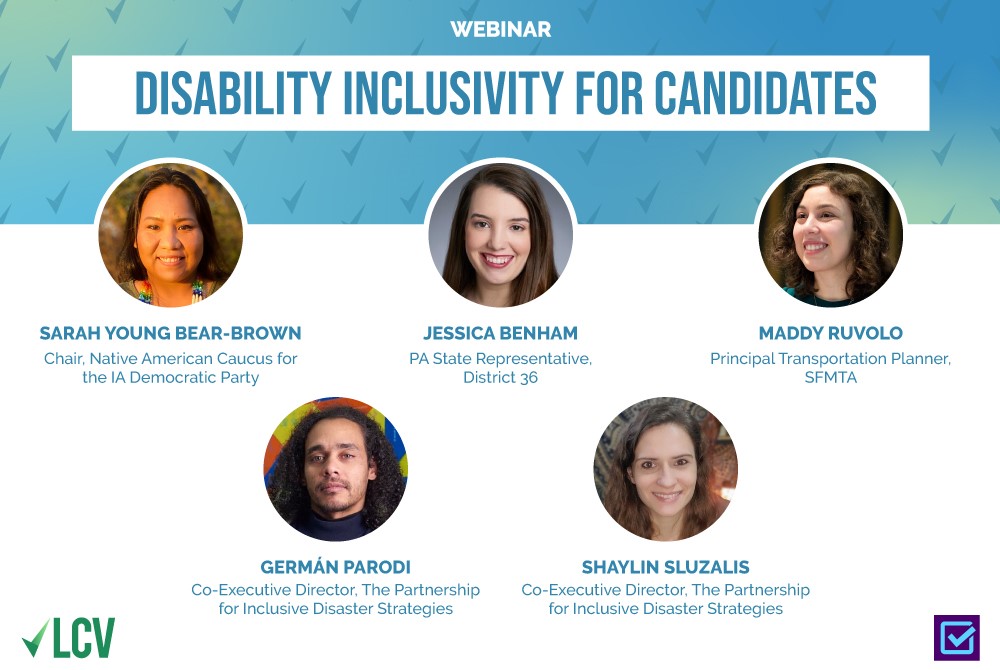Good Climate News this Week: National Monument Expansions, Lead Pipe Removal, Clean Energy Permitting, and More!
May 3, 2024
 The panel of speakers featured during the "Disability Inclusivity for Candidates" webinar held by LCV and Disability Victory.
The panel of speakers featured during the "Disability Inclusivity for Candidates" webinar held by LCV and Disability Victory.
At a webinar held by LCV’s Candidate Academy and Disability Victory, Germán Parodi, from the Partnership for Inclusive Disaster Strategies (PIDS), pointed to the train derailment last year in East Palestine, Ohio as an example of what can go drastically wrong when the needs of people with disabilities aren’t considered in a disaster.
The connection between environmental and disability policy is critical, and often overlooked. People with disabilities are two to four times more likely to be injured or die in an emergency due to the lack of planning for their needs in an evacuation or other disaster situation. With the rising number of climate change fueled disasters like floods, heat waves and hurricanes, it’s crucial for climate adaptation and disaster response plans to account for the needs of people with disabilities.
LCV’s Candidate Academy, a program for environmental leaders running for office, held a webinar in partnership with Disability Victory exploring how candidates can make their campaigns and platforms inclusive for people with disabilities. An all-star group of speakers who work in city planning, disaster response, state government, and campaigns shared their lessons on policies and practices for disability inclusivity.
First and foremost, it’s essential to include people with disabilities in the planning process from the beginning, the speakers said. The best way to mitigate disproportionate harm to disabled constituents is to create regular, accessible ways for them to be involved in planning. Forming an advisory committee or holding regular town halls can facilitate inclusion. As an example, Maddy Ruvolo, a Transportation Planner with the San Francisco Metropolitan Transportation Authority, shared how she collaborates with a group of disabled community leaders to help assess how well the system is working and plan improvements.
Creating places for disabled leaders to be heard also builds relationships that can help in the event of a disaster. With connections between them already established, officials and community leaders can more easily share information during an emergency and work together to get critical resources to disabled constituents.
Beyond having those lines of communication open, how information is communicated is just as important. Sarah Young Bear-Brown, an activist and advocate for the Indigenous Deaf community, explained that a lack of live interpreters for emergency coverage prevents Deaf people from getting critical information. “A lot of people in the Deaf community overlook news information… oftentimes we have no idea what is happening due to missing information and not having access,” she said.
She highlighted the importance of picture-in-picture interpretation for news programs and conferences to ensure that Deaf people have full access to information in their native language. “[We need] to have that rapid access to information with emergency response and preparedness.”
On top of communication barriers, lack of adequate transportation is often a problem in emergency situations. PA State Rep. Jessica Benham pointed out that when aid distribution points are established following a disaster, people are usually expected to transport themselves there. That poses an additional hurdle for people with disabilities, who are less likely to have access to transportation especially if public transit is disrupted. Often, people with disabilities are also more vulnerable to health hazards they may be exposed to if they have to travel or navigate crowds.
Healthcare needs can also present other challenges. For example when Hurricane Maria hit Puerto Rico in 2017, many people with disabilities were evacuated to Florida and other states due to the long-term lack of infrastructure and electricity following the disaster. But because Medicaid benefits aren’t portable across state lines, many had trouble accessing the in-home supportive health services that they had in Puerto Rico.
In response to that situation and more ways recent disasters disproportionately impacted people with disabilities, our speakers from the Partnership for Inclusive Disaster Strategy worked with members of Congress on two bills currently in the legislature. The Real Emergency Access for Aging and Disability Inclusion (REAADI) for Disasters Act would create a National Commission on Disability Rights and Disasters to establish standards to meet the needs of older adults and people with disabilities in disaster preparedness and response at the federal, state, tribal, and local levels; create a national network to assist in implementation; establish grants for inclusivity programs; and more. The Disaster Relief Medicaid Act (DRMA) would ensure that Medicaid benefits would still be available in the event of relocations due to disaster situations.
Whether in an emergency situation or in everyday life, the speakers noted that the same policies and infrastructure that benefit disabled people generally benefit everyone. For example, improvements to mass transit often geared toward disabled people, such as bus shelters designed to offer protection during heat waves, better lighting at transit hubs, and more frequent buses and trains, can encourage more people overall to use the transit system. And more people using transit means fewer fossil-fuel burning cars on the road. In this and many other ways when fighting climate change or preparing for disasters, sound disability policy is also sound environmental policy.
Our country urgently needs more leaders who share our vision of a world with a healthy environment and healthy communities, protected by a just and equitable democracy. To empower more people in our movement to become leaders, LCV and our state affiliates offer robust leadership development opportunities. Read more about LCV’s Candidate Academy and other programs.